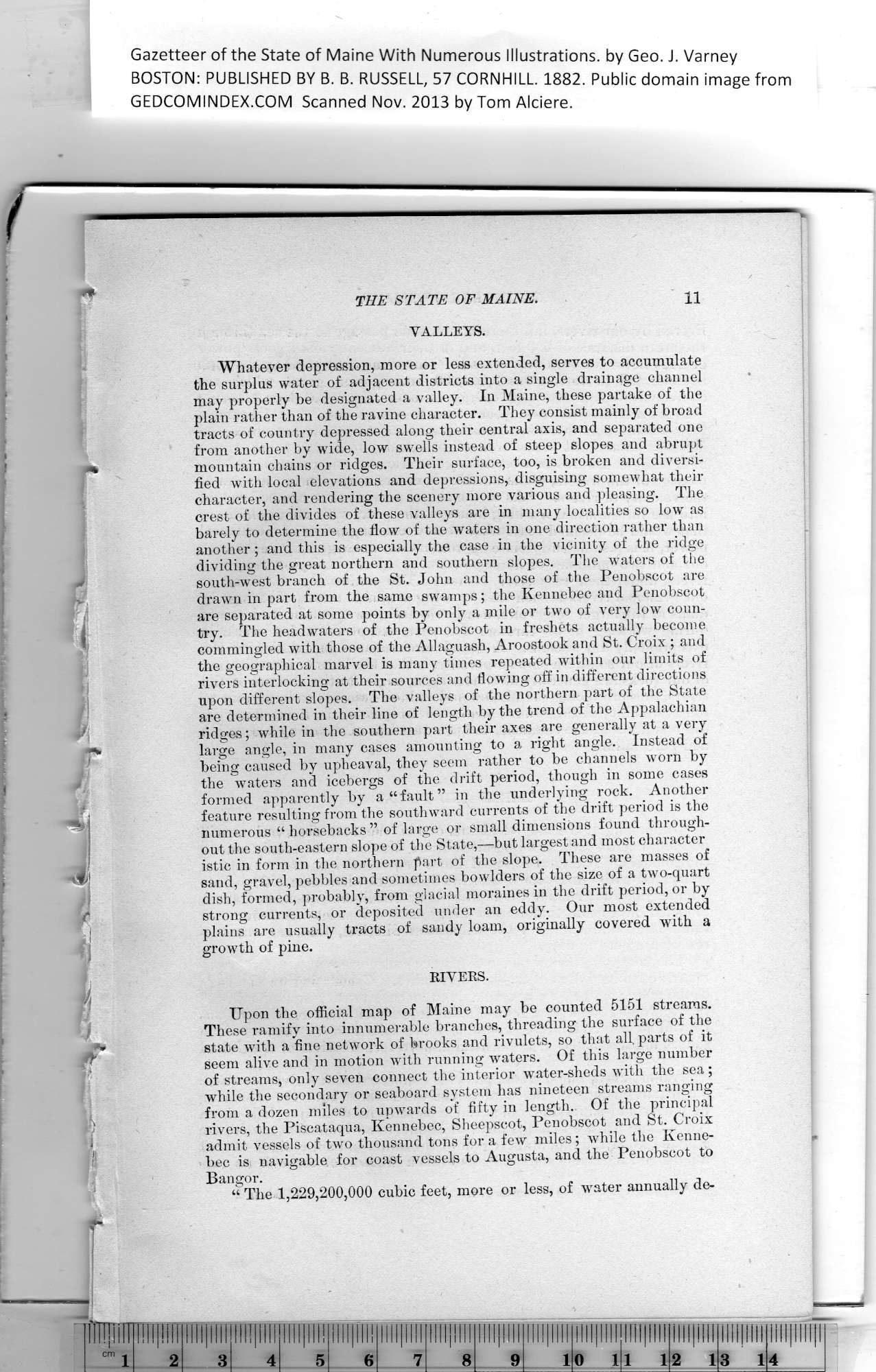|
Gazetteer of the State of Maine With Numerous Illustrations, by Geo. J. Varney
BOSTON. PUBLISHED BY B. B. RUSSELL, 57 CORNHILL. 1882. Public domain image from
Whatever depression, more or less extended, serves to accumulate
the surplus water of adjacent districts into a single drainage channel
may properly be designated a valley. In Maine, these partake of the
plain rather than of the ravine character. They consist mainly of broad
tracts of country depressed along their central axis, and separated one
from another by wide, low swells instead of steep slopes and abrupt
mountain chains or ridges. Their surface, too, is broken and diversi-
fied with local elevations and depressions, disguising somewhat their
character, and rendering the scenery more various and pleasing. The
crest of the divides of these valleys are in many localities so low' as
barely to determine the flow of the waters in one direction rather than
another; and this is especially the case in the vicinity of the ridge
dividing the great northern and southern slopes. The waters of the
south-west branch of the St. John and those of the Penobscot are
drawn in part from the same swamps; the Kennebec and Penobscot
are separated at some points by only a mile or two of very low coun-
try. The headwaters of the Penobscot in freshets actually become
commingled with those of the Allaguash, Aroostook and St. Croix ; and
the geographical marvel is many times repeated within our limits of
rivers interlocking at their sources and flowing off in different directions
1 npon different slopes. The valleys of the northern part of the State
' are determined in their line of length by the trend of the Appalachian
c . ridges; while in the southern part their axes are generally at a very
large angle, in many cases amounting to a right angle. Instead of
being caused by upheaval, they seem rather to be channels worn by
the waters and icebergs of the drift period, though in some cases
formed apparently by a “ fault ” in the underlying rock. ^ Another
i feature resulting from the southward currents of the drift period is the
j numerous “ horsebacks ” of large or small dimensions found through-
I out the south-eastern slope of the State,—but largest and most character
istic in form in the northern part of the slope. These are masses of
sand, gravel, pebbles and sometimes bowlders of the size of a two-quart
/j dish, formed, probably, from glacial moraines in the drift period, or by
f strong currents, or deposited under an eddy. Our most extended
j plains are usually tracts of sandy loam, originally covered with a
' growth of pine.
, RIVERS.
/j
Upon the official map of Maine may be counted 5151 streams.
These ramify into innumerable branches, threading the surface of the
* state with a fine network of brooks and rivulets, so that all. parts of it
seem alive and in motion with running waters. Of this large number
of streams, only seven connect the interior wTater-sheds with the sea;
while the secondary or seaboard system has nineteen streams ranging
. from a dozen miles to upwards of fifty in length. Of the principal
rivers, the Piscataqua, Kennebec, Sheepscot, Penobscot and St. Croix
■ admit vessels of two thousand tons for a few miles ; wTiile the Kenne-
r bee is navigable for coast vessels to Augusta, and the Penobscot to
Bangor.
“ The 1,229,200,000 cubic feet, more or less, of water annually de-
PREVIOUS PAGE ... NEXT PAGE
This page was written in HTML using a program written in Python 3.2
| 